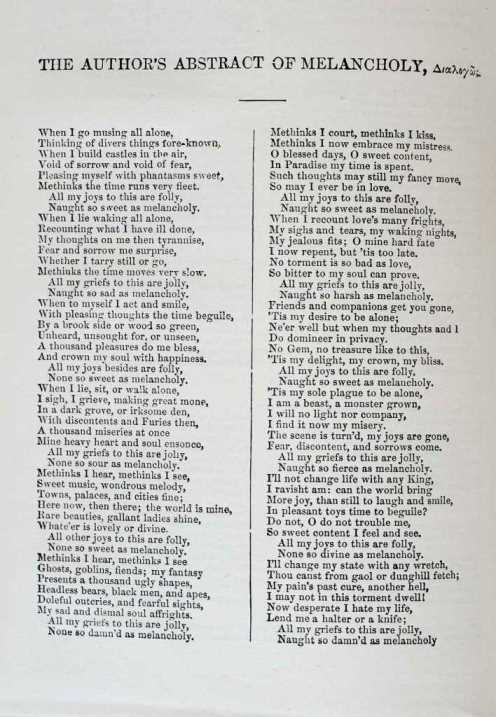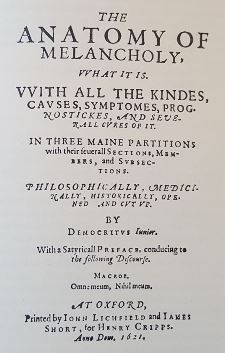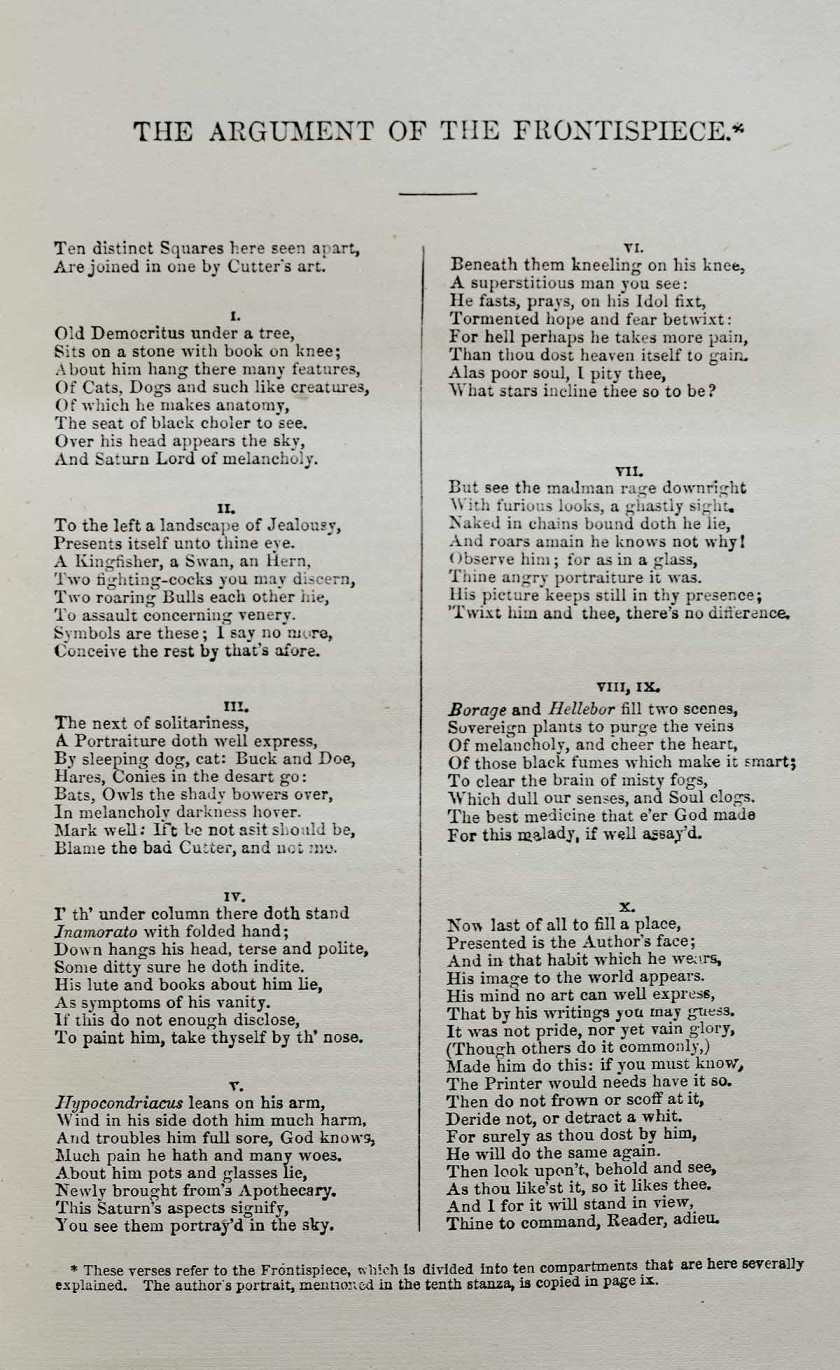Support us
As a charity we rely on your donations to fund our free exhibitions, school activities and online resources
Empowering medical excellence, shaping healthcare futures.
“The work now restored to public notice has had an extraordinary fate. At the time of its original publication it obtained a great celebrity, which continued more than half a century. During that period few books were more read, or more deservedly applauded. It was the delight of the learned, the solace of the indolent, and the refuge of the uninformed.” (Preface to Robert Burton’s The Anatomy of Melancholy, 1907.)
In 1621, Robert Burton (1577-1640) wrote and published the world’s first psychiatric encyclopaedia, an exhaustive study which is the result of his life’s work. The Anatomy of Melancholy quickly became one of the most popular books of the seventeenth-century and is still an influential work in the study of mental illness and depression. Although Burton described his subject as ‘melancholy’, his work explores a wide array of afflictions, one of which would be referred to today as depression.

Prompted to write this text by his own experiences with depression and his philosophical readings, Burton approached the idea of melancholy from both medical and divine perspectives. He aimed to investigate wholly the malady that had troubled him throughout his life and commented that he hoped to cure himself of his problems by staying busy and by occupying himself by writing about his illness. The book is divided and subdivided into many sections, in which Burton attempted to define different types and causes of melancholy, list its symptoms, and provide possible cures.

Based on its publication history, The Anatomy of Melancholy was more popular in the seventeenth-century than Shakespeare! The book was printed five times within Burton’s lifetime and three times more within the first twenty years after his death. There have now been almost one hundred editions of this seminal text, and its influence is still felt. The text is included in Morton’s Medical Bibliography as one of the most important contributions to medical literature, and in 1963, more than three hundred years after its original publication, the book was featured in the celebrated exhibition “Printing and the Mind of Man” due to its lasting influence on humankind’s collective mind and history.
The Anatomy was Burton’s life work and he continually edited and altered the text until his death. The first edition in 1621 contained a massive 353, 369 words, similar in length to Charles Dickens’ Bleak House. But by the time the sixth, posthumous, edition was published in 1651 with thirty years of corrections and additions, that number had risen to 516, 384 words, almost as long as Victor Hugo’s epic Les Miserables.
The Royal College of Physicians of Edinburgh holds five copies of the Anatomy, including the eighth edition from 1676 and a 1986 collector’s edition reprint of the 1845 edition. While the 1676 edition is a large folio bound in leather, the later editions are less decorative and seem to have been designed for use, rather than display. All bar the 1821 edition feature the remarkable frontispiece (above) and accompanying poem. The elaborate title page was engraved by Christian Le Blon and features nine images relating to melancholy alongside portraits of Democritus (the laughing philosopher) and the author (in the persona of Democritus Junior). The images include symbols of jealousy, loneliness, hypochondria, superstition, madness, and two medicinal plants, borage and hellebore. Although the frontispieces are very familiar, there are some slight differences between the images, notably the considerable aging of the author between 1628 and 1676!

Stuffed full of interesting treatises on the mind, body and soul, as well as lengthy quotations from other works, the Anatomy has been described as “the finest curiosity-shop in English literature … an inexhaustible catalogue of human foibles” (Carter, 1954). Whether an early edition or a modern reprint, everyone interested in the history of medicine should have this pivotal work on their bookshelf. (Or at least pop into the College to see ours!)

Author: Isla Macfarlane, Intern, University of Edinburgh, MSc Book History and Material Culture.
References
Bamborough, J. B. “Burton, Robert (1577-1640), writer.” Oxford Dictionary of National Biography, 2004. Oxford University Press. http://www.oxforddnb.com/view/10.1093/ref:odnb/9780198614128.001.0001/odnb-9780198614128-e-4137
Burton, Robert. The Anatomy of Melancholy. Oxford, 1621.
Carter, H. S. “Robert Burton and The Anatomy of Melancholy.” Glasgow Medical Journal, vol. 35, no. 8. 1954, p.202.
Carter, John, et al. Printing and the Mind of Man: A Descriptive Catalogue Illustrating the Impact of Print on the Evolution of Western Civilization During Five Centuries. Cassell and Company, 1967.
Evans, Bergen. The Psychiatry of Robert Burton. In consultation with George J. Mohr, Columbia University Press, 1944.
Michael, Lincoln. Infographic: Word Counts of Famous Books. Electric Lit, 2014. https://electricliterature.com/infographic-word-counts-of-famous-books-161f025a6b09

Support us
As a charity we rely on your donations to fund our free exhibitions, school activities and online resources